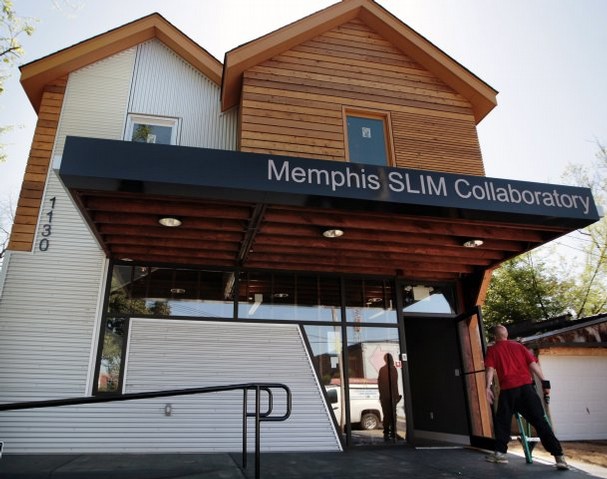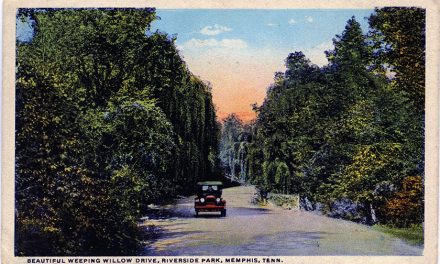Three of our favorite Memphians – Cardell Orrin, Charles Santo, and Eric Robertson – have made substantial progress on their Memphis Music Magnet project with the opening of the former house of Memphis Slim as the Memphis Slim Collaboratory.
In only six years, the project moved from concepts with the students in Professor’s Santo’s regional planning class at University of Memphis to on-the-ground improvements in the Soulsville neighborhood. At a time when we are celebrating the energy and improvements generated by guerilla urbanists, it’s worth celebrating three people who combined the best of a DIY attitude and a deep urbanism with the quality research and planning that attracted local and national attention to their plans.
That’s not to say that it’s been easy. In fact, it’s hard to imagine three other people who could have pulled it off.
Future plans call for musicians’ housing and neighborhood improvements. Resources in the $365,000 Collaboratory are decidedly professional. There is soundproof rehearsal space, a training studio where musicians can make demos, and space for workshops on the music business. The house is wired with the latest technology for video streaming.
Building on Anchors
The Memphis Slim Collaboratory is across College from the Stax Museum of American Soul Music. If you haven’t visited Soulsville lately, it’s just the latest reason to do so. It is exciting to watch the progress being made there, because there are so many lessons to be learned: the power of inspired leaders and students to drive change, the power of the arts and culture to become a fulcrum for change, and the power of neighborhood redevelopment to redefine the aspirations of a place.
Memphis Music Magnet was developed to build on the neighborhood anchors of the Stax Museum of American Soul Music and the Stax Music Academy and to augment the redevelopment of the Soulsville neighborhood by making it a community of choice for musicians, music-related creatives, and other artists.
Professor Santo explained it well: “Traditionally, cities came about because of clustering for trade, and cultural amenities were the side effects. The things that used to be side effects are now critical to the economy. They have gone from being the icing on the cake to being the cake itself. That’s what the Memphis Music Magnet is all about.”
We’ve been writing about the Memphis Music Magnet since 2009, and it’s a bold plan and it needed uncommon diligence and discipline to succeed. There’s also no substitute for dedication, smartness, and creativity. Early on, Mr. Robertson said that “failure is not an option” and clearly that approach has worked.
Significant support for the project came from ArtPlace, and it said volumes about Memphis Music Magnet. It was one of 47 “creative initiatives” chosen from 2,200 applications for funding from the $15.4 million, and it was funded under the heading of using “Using Art to Spark Redevelopment.” It received the third largest funding of all the projects. Other important funding support came from the Kresge Foundation, the Hyde Family Foundation, and the Assisi Foundation.
Fat Times for Memphis Slim House
The overlapping goals of the Memphis Music Magnet are 1) Promoting neighborhood revitalization through physical and cultural renovation; 2) Supporting an economic development target industry through an alternative approach to economic development; 3) Infusing and sustaining creativity in Memphis; and 4) Creating a catalyst for development and growth in Soulsville USA.
To all of this, we can say only one thing about Memphis Music Magnet: Let’s get it done and done right. Mr. Orrin, Professor Santo, and Mr. Robertson have shown us how it can be done. Now all we have to do is support the continued implementation of their visionary plan.
As for Memphis Slim, it’s a good time to remember his classic Memphis Music story: the story line begins in South Memphis, includes honky-tonks, dance halls, and gambling joints in the MidSouth, then a move to Chicago where he recorded with the other greats of his day, and finally to live in Paris, France, where he died in 1988 at the age of 72. Two years before he died, he was named a commander in the Order of Arts and Letters by the Ministry of Culture for France.
It’s the kind of story that has been replicated so many times in Soulsville as legendary musicians walked from the neighborhood or drove in from across the South to record at Stax Records with its legendary musicians and timeless sound.
Soulsville Matters
In 2007 and 2008, the idea for the Memphis Music Magnet grew out of Professor Santo’s graduate planning classes at University of Memphis, where students were challenged to conceive of a way to tie creativity to revitalization. The concept was to create neighborhood-level change by attracting and supporting musicians and by using music as a tool for community engagement; to target homeownership incentives and housing programs for musicians; and to develop affordable rehearsal space.
To see the Memphis Music Magnet plan, click here.
The owner of the Collaboratory is Lemoyne Owen College Community Development Corporation and back in 2009, its executive director, Jeffrey Higgs is eloquent on the importance of the Soulsville neighborhood: “The idea of creating an artistic community in Soulsville USA is a great idea, not only for what it brings to this City but what it tries to capture…the essence of the music industry TODAY. Which is a vital part of the history of Memphis, and it is not just EP or BB, it is the creative class of minds young and old that says yes we can, have a vibrant and lively music scene and residential community as well that celebrates music and the economics associated with it.
“And why not SOULSVILLE USA? Over $150 million in revitalization activity, the City’s only HBCU, Elmwood Cemetery, Soulsville Foundation, East Trigg Missionary Baptist Church, Memphis Slim’s House, Aretha Franklin Childhood Home, J. E. Walker House, Historic Fountain Court, Rouhlac Mansion Bed and Breakfast, Firehouse Black Arts Alliance, Boys and Girls Club, Four Way Grill, College Park, Towne Center at SoulsvilleUSA and the people who make this neighborhood vibrant and contribute to the mosaic of diversity and a sense of being…a sense of place.
“All this to ensure that change in its self-image is one positive step to being a better neighbor and neighborhood. One cannot stand on the outside and get involved in this notion of perception, but one must immerse themselves in the fabric of the neighborhood to see the good and the changes that have occurred.
“SOULSVILLEUSA and its residents are working to become a place that welcomes everyone, everyone that is trying to make this neighborhood a better place to live, work and play. I can assure you that the people of this neighborhood are hard-working and honest people that want the same things that others may want for their own neighborhoods – positive economics, green spaces, and an environment that is lively and inviting to all.”





this is awesome! congrats and thank you to all who made this happen!
What a great project!